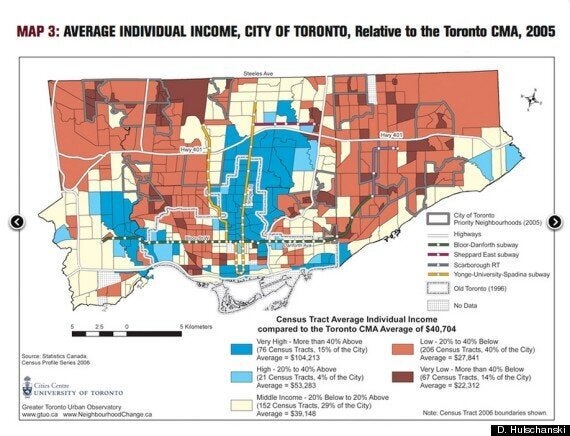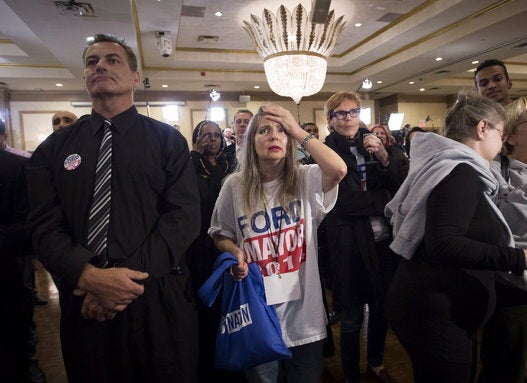Last night in Toronto, a bunch of lawn-mowing, SUV-driving suburbanites got together with a bunch of bike-riding, latte-sipping downtown yuppies and elected John Tory mayor.
So Toronto's great political divide, the City versus the Suburbs, has finally been conquered, right? Yes. And no. That is to say, it never really existed.
What happened last night was that the city's true and growing division came to light.
The Tory-voting urbanites and suburbanites may live very different lives in their various corners of the city, but they do have something in common: They are likely to be among the higher earners in the city.
You probably remember that map from the 2010 mayoral race, showing a clear divide among urban (George Smitherman) voters and suburban (Rob Ford) voters.
Well here's the new map, from last night's election. John Tory's deep blue runs straight down the centre of the city, and then outwards from the centre along the lake. Olivia Chow's orange is concentrated in the Parkdale/High Park area, an NDP stronghold. And the rest, the light blue, is Doug Ford.
Now take a look at this map, from David Hulchanski's "Three Cities" report, in which the U of T professor shows how Toronto is growing increasingly segregated along income lines. Notice any similarities?

The upside-down 'T' that is John Tory's domain contains most of the city's wealthiest enclaves -- Rosedale, Bridle Path, Royal York, Forest Hill. It also contains the neighbourhoods of the city's young and soon-to-be rich -- Yonge-Eglinton, City Place etc.
This is the part of Toronto that Hulchanski calls "City #1" -- "a predominantly high-income area ... in which neighbourhood incomes have risen a great deal relative to the [metropolitan] average since 1970."
This area also coincides with where the subway stations are -- that's right, Toronto's subways, meant to service the city's lowest income commuters, run through what are now the wealthiest parts of town.
No wonder both Rob and Doug Ford kept shouting "subways, subways, subways." The Ford nation parts of the city are the ones that need transit the most, and have the least of it.
Ford, Chow and Tory split much of what Hulchanski calls "City #2," the ever-shrinking middle-income part of the city, in white on the map above, and Ford took all of "City #3" -- "a generally low-income area ... in which neighbourhood incomes have fallen substantially over the past few decades compared to the [city] average."
The parts of the city won by Ford are the parts that have been left behind in the new economy -- the blue collar workers, the underemployed immigrants, the aging widows living on fixed incomes; the people who have been marginalized both in the economy and physically in the city.
In this context, it's easy to see why Doug Ford attacked John Tory for being a Bay Street elitist.
It's also to easy to see that Toronto's divisions -- political, economic and otherwise -- were in no way bridged by last night's vote.
